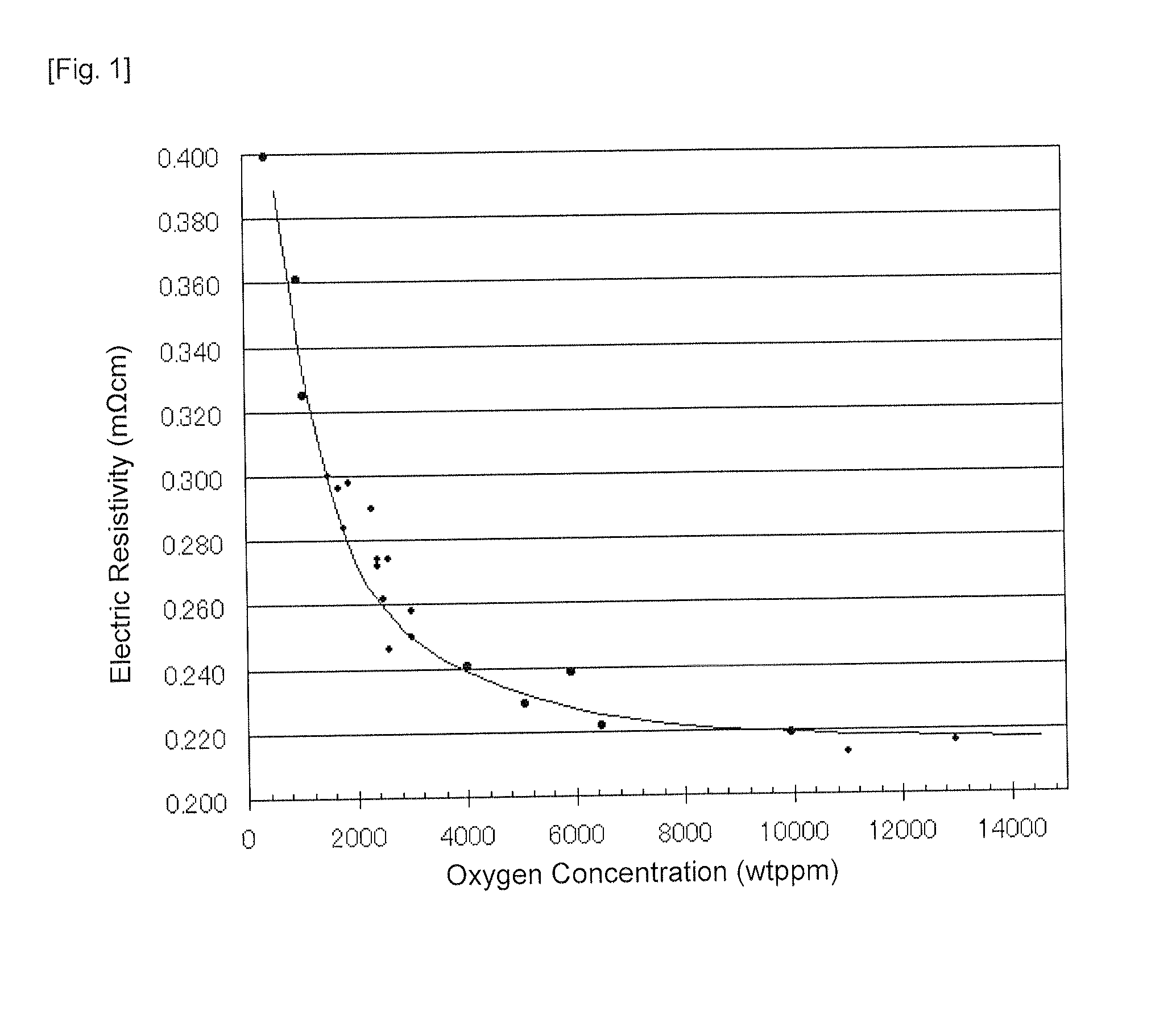Target of Sintered Compact, and Method of Producing the Sintered Compact
- Summary
- Abstract
- Description
- Claims
- Application Information
AI Technical Summary
Benefits of technology
Problems solved by technology
Method used
Image
Examples
example 1
[0064]The raw powders of Te, Sb and Ge respectively having a purity of 99.999% (5N) excluding gas components were mixed and melted to obtain a composition of Ge22.2Sb22.2Te55.6 (at %), and slowly cooled in a furnace to prepare a cast ingot.
[0065]The raw materials of the respective elements were subject to acid cleaning and deionized water cleaning prior to the melting process in order to sufficiently eliminate impurities remaining particularly on the surface.
[0066]Consequently, a high-purity Ge22.2Sb22.2Te55.6 ingot maintaining a purity of 99.999% (5N) was obtained. Subsequently, the high-purity Ge22.2Sb22.2Te55.6 ingot was pulverized with a ball mill to prepare raw powder having an average grain size of approximately 30 μm, and a maximum grain size of approximately 90 μm (the values were round to the 10).
[0067]This raw powder was oxidized by being subject to heat treatment for 6 hours at 350° C. in the atmosphere (oxygen concentration: 20.90%). The oxygen content was 5000 wtppm.
[00...
example 2
[0072]The same raw powder as Example 1 was used up to the pulverization process, and this raw powder was oxidized by being subject to heat treatment for 12 hours at 350° C. in the atmosphere (oxygen concentration: 20.90%). The oxygen content of the raw powder was 7500 wtppm. The subsequent sintering conditions and final HIP treatment conditions were the same as Example 1 for manufacturing a sputtering target.
[0073]The thermal conductivity of the target material manufactured as described above was 3.2 W / mK, and the electric resistivity was 0.24 mΩ·cm. This target material was bonded with a copper alloy backing plate to obtain a sputtering target.
[0074]DC (direct current) magnetron sputtering was performed using this sputtering target. The DC (direct current) magnetron sputtering could be performed even easier than Example 1, and the sputtering rate increased.
[0075]The arcing generation rate was less than once per minute and the particle generation rate was 20 particles or less. The p...
example 3
[0076]The same raw powder as Example 1 was used up to the pulverization process, and this raw powder was subject to heat treatment for 24 hours at 350° C. in a high oxygen atmosphere (oxygen concentration in the atmosphere was increased so as to achieve an oxygen concentration of 50%). The oxygen content of the raw powder was 10000 wtppm.
[0077]The subsequent sintering conditions and final HIP treatment conditions were the same as Example 1 for manufacturing a sputtering target. The thermal conductivity of the target material manufactured as described above was 3.5 W / mK, and the electric resistivity was 0.22 mΩ·cm. This target material was bonded with a copper alloy backing plate to obtain a sputtering target.
[0078]DC (direct current) magnetron sputtering was performed using this sputtering target. The DC (direct current) magnetron sputtering could be performed even easier than Example 1 and Example 2, and the sputtering rate was extremely high.
[0079]The arcing generation rate was le...
PUM
| Property | Measurement | Unit |
|---|---|---|
| Fraction | aaaaa | aaaaa |
| Fraction | aaaaa | aaaaa |
| Fraction | aaaaa | aaaaa |
Abstract
Description
Claims
Application Information
 Login to View More
Login to View More - R&D
- Intellectual Property
- Life Sciences
- Materials
- Tech Scout
- Unparalleled Data Quality
- Higher Quality Content
- 60% Fewer Hallucinations
Browse by: Latest US Patents, China's latest patents, Technical Efficacy Thesaurus, Application Domain, Technology Topic, Popular Technical Reports.
© 2025 PatSnap. All rights reserved.Legal|Privacy policy|Modern Slavery Act Transparency Statement|Sitemap|About US| Contact US: help@patsnap.com


